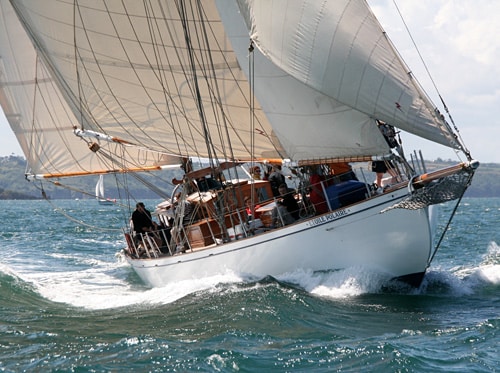
Etoile Polaire
As anyone who sails knows, almost anything can happen on the water, especially during long-distance stretches of 500 miles or more. The stakes are especially high for the skipper when they are responsible for the well being of an inexperienced crew. These two risks were compounded by the sheer number of participants during Sail Training International’s annual Tall Ships Races that took place in July and August. The regatta drew 1,800 participants, most of whom had little or no ocean miles under their belts, to sail on one of 55 ships over 2,000 miles in the Atlantic, English Channel, and Irish Sea.
I also got to observe from afar what can go wrong during such a long-distance regatta, which began a few weeks ago at St. Malo, France. A close friend’s son, Francois Guivarch, was sailing on the Etoile Polaire, a German-built, 98-year-old ketch yacht, which local fleet owner Bob Escoffier partially refurbished and now rents.
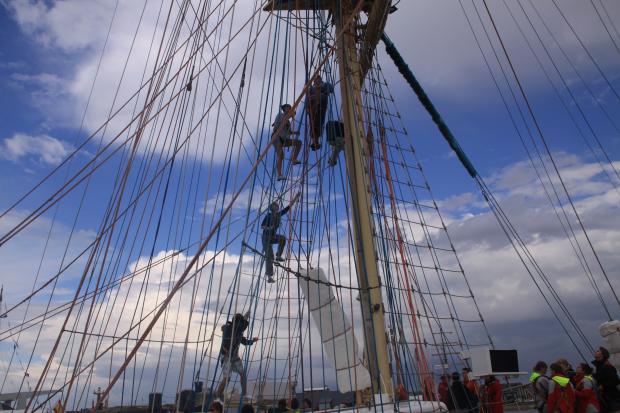
Trainees on Pogoria learn how to go aloft in port
The Etoile Polaire was just one design among many at the regatta. The ships ranged from smallish 30-foot sloops to full-rigged boats, such as the 180-foot Lord Nelson, which was also outfitted to accommodate sailors with disabilities.
The main purpose of the Tall Ships Races is to acquaint young people between the ages of 15-18 who have little or no experience with long-distance sailing and racing. It can also serve as an opportunity for youngsters to sail more independently, i.e. without their parents in tow. As fathers and mothers often learn the hard way, your children, no matter how hard you try, are not necessarily going to share your passion. Or if they do, they often will want to race with their friends and leave the old folks on another boat.
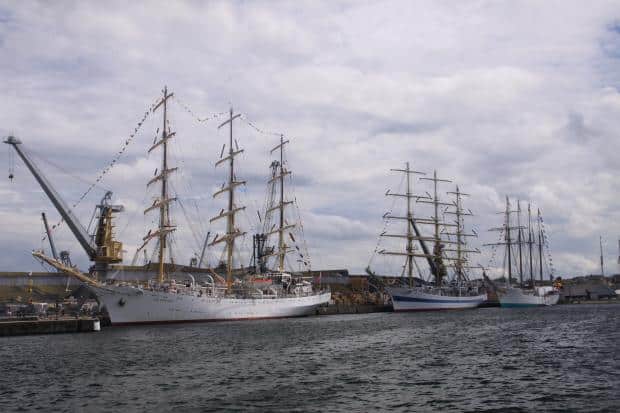
Dar Mlodziezy, Mir and _Juan Sebastia De Elcano _
That was the case with Francois. He likes to sail and learned the basics on an Optimist while taking classes, which the local public grade school offers to all of its students. He also learned the ropes while sailing with his father on the Rance River and in the English Channel near St. Malo. But what drew him to the race was the adventure of sailing such a long distance from St. Malo to Lisbon, Portugal, with mostly people his own age.
“I like sailing with my father, okay,” Francois said on the eve of the race. “But I have to admit that sailing with young people is more fun.”
When I visited the_ Etoile Polaire_ the day before the start of the race, the first thing that I noticed were the diesel fumes down below. It turned out that whoever had filled the gas tank had let it overflow, filling the ship with fumes that would last for several days. I was nauseous after a few minutes. Not good.
I had a better experience when I met the Etoile Polaire‘s French skipper, Bérangère Branchereau. She told me it was the first time that she had skippered a ship like the Etoile Polaire with over a dozen of inexperienced sailors in tow. She said her main goal was “for the kids to have fun,” but the regatta was also a race, and she wanted to motivate the kids as much as she could without pushing them too hard.
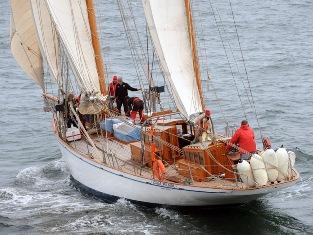
Etoile Polaire
“The kids will become used to working on the boat, and will learn how to push themselves, while sharing the chores,” Bérangère said. “It will require a personal commitment from each one of them, because in order to sail a ship like this over long distances, everyone must do their part. It is not a vacation.”
I left feeling uneasy about the fumes. I also saw that the fleet was sailing into a low-pressure zone that was veering towards western France and into the English Channel. My apprehension was justified when the low pressure system began building into a full-blown gale the next day, into which the_ Etoile Polaire_ and the rest of the fleet were headed.
Three days after the start of the race, I was preparing to sail over the English Channel from Roscoff, France, to the Scilly Isles on a 27-foot French-made Feeling cruiser before the worst of the front hit. But just as we were getting ready to head out of port, I got a surprise call: I learned that Francois had suffered from sun poisoning and possibly an allergic reaction and was being airlifted by helicopter to a hospital in Brest. I was to alert his father, who did not have a cell phone and was on the boat with me about to leave for the Scilly Islands.
After driving Francois’ father to the hospital in Brest (the father was in no condition to drive), I was relieved to see that Francois was okay overall, besides his suffering from easily treatable first-degree burns.
But life onboard the_ Etoile Polaire_ had not been so rosy during the past couple of days, Francois said. Everyone on board, except for the skipper, had been very ill due to the diesel fumes and the motion of beating up wind in very choppy, low-period waves.
Francois also said that Bérangère managed to get everybody (who was able to) to grind the winches, steer the boat, prepare the food, and everything else without shouting once. She was very busy and did “seem stressed out,” but everything went okay, Francois said.
Then I saw what the Etoile Polaire was headed into the day after Francois had been airlifted to the hospital on the way to the Bay of Biscay: steady west-southerly winds of 30 knots with gusts of 40 knots and a rough to very-rough sea state. My thoughts remained with the Etoile Polaire during the next 48 hours, as I wondered how Bérangère was getting along. Meanwhile, we weathered out the gale in the relative comfort of the port since conditions had become way too nasty now to sail across the Channel to the Scilly Islands.
A few days later I breathed a sigh of relief when the Etoile Polaire made it safely to Lisbon, while three other boats in their class had to abandon the leg. The Etoile Polaire then continued on the next leg of the race, eventually arriving safely in Cadiz, Spain. But while en route to Coruna, Spain, from Cadiz, the helm suffered a breakage and the Etoile Polaire had to be towed back to port.
Other ships in the fleet fared even worse than the Etoile Polaire did later in the race, such as the Polish Kapitan Borchardt, a 90-foot schooner that struggled to arrive at the final stop in Dublin with a broken mast and no power following 60-knot gusts and up to 30-foot waves. Fortunately, no serious injuries were reported on any of the ships. The Cuauhtemoc, a three-masted ship from Mexico, won the overall race, averaging over 10 knots during the last leg from Coruna to Dublin.
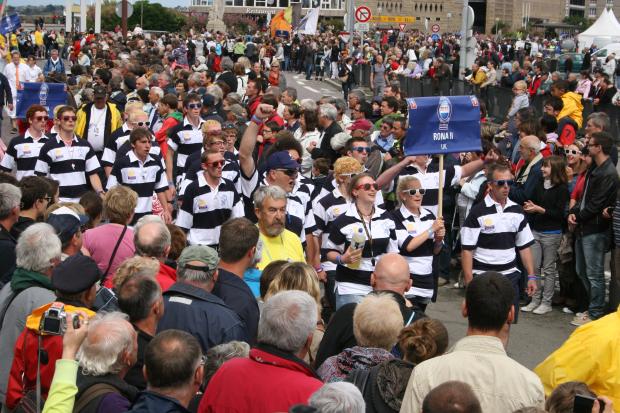
Crew parade
I asked Bérangère what she took away from the adventure when I called her after the regatta was over. She conceded that the journey from Brest on the edge of the Bay of Biscay was the biggest test. It was especially challenging to motivate the youngsters to do what they needed to do in the cold and wet as they sailed over rough seas into the wind, which was indeed blowing a steady 30 knots and very gusty. But she also said that she was ready to do the entire journey again and was pleasantly surprised by the reactions of the youngsters.
“The kids remained cheerful, even during the worst part of the trip, and I was amazed by how fast they could adapt,” she said. “For me, observing them was a learning experience in and of itself.”
As for Francois, he said his overall experience had been a positive one, despite the sunburn incident and the rough passage. He said he was ready to give long-distance sailing, and even racing, another try, which is the kind of reaction that the organizers of the race probably want to hear about. Still, he did turn down the opportunity to race with his father on a seven-mile course the following month.









